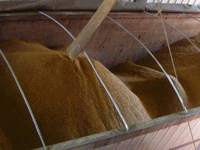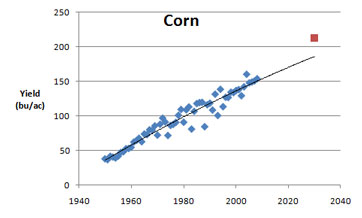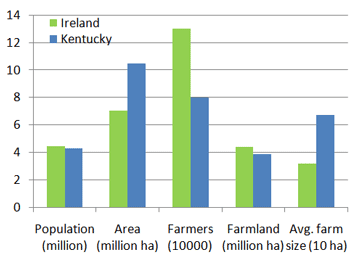Can't find what you're looking for?
The Energy Farms network blog recently moved to a new WordPress server. Only the most recent posts were transferred. Older posts are archived here.
Solar greenhouses, Chinese-style

Dr. Sanjun Gu in a Chinese-style solar greenhouse with a cucumber crop planted in September and harvested between December and April. Shandong, China, April 1998.
In Europe and North America, eating fresh perishable produce out of season usually means hauling it in refrigerated containers from regions where it’s in season, or growing it locally in heated greenhouses. Our large greenhouses tend to use technology developed in Holland: Huge boilers burn through prodigious amounts of natural gas, coal, wood, or other fuel to fill a network of pipes with hot water, radiating heat into vast leaky structures clad in a single pane of glass. Although these greenhouses boast extremely high yields, the amount of fuel needed to heat them generally far exceeds the amount that would be needed to haul an equivalent amount of produce from a region where it’s in season.
There are alternatives. One is the high tunnel, a simple unheated hoop structure clad in clear plastic. Small farmers in North America are increasingly building high tunnels to extend their growing season without spending a lot of money on energy-intensive technology.
Another alternative is a greenhouse design developed in northern China in the mid-1980s that relies primarily or entirely on solar energy for heat. By 2000 these greenhouses already covered about 260 thousand hectares (650 thousand acres) in northern China, and by 2004 they were supplying residents of northern China with 90% of their fresh produce in winter. That’s when Manitoba vegetable farmer Wenkai Liu first brought the technology to North America. Other Manitoba growers have adopted the design since then, but, to my knowledge, it has yet to be tried in other regions of Canada or the United States.
Farm Scale Study: Results from 2009 field season
Part of the reason for blogging about our farm scale study is my belief that data should be openly accessible. I wanted to post results as we collected the information, to make the study available for continuous review by anybody interested in the project.
My idealism has fallen prey to time constraints. Instead of posting each new chunk of data as the growing season progressed, I am finally posting a season summary now that the 2009 harvest is stored and snow is on the ground.
As in 2008, we grew corn, soybean, sweet potato, and sweet sorghum organically at three different farming scales:
Ireland and Kentucky: Contrasting Biofuel and Energy Plans
Thanks to Anna Galovich for a Spanish translation of this article.
Ireland and Kentucky have a surprising amount in common, but they’re charting very different courses for their energy future. Ireland is a moderate energy consumer with a plan to reduce its energy use. Kentucky is a profligate energy user planning to increase its consumption. Biofuels play a big part in the energy plans for both, but will likely have different impacts.
Ireland and Kentucky both have just over 4 million inhabitants and about 4 million hectares (10 million acres) of farmland. Kentucky is about 50% bigger than Ireland, but more of it is forested.
Both have two large cities, with most people living in small towns and villages. Ireland has Dublin and Cork (metro pop. 1.6 and 0.3 million, respectively); Kentucky has Louisville and Lexington (metro pop. 1.2 and 0.5 million, respectively).
Both have a lot of farms, relative to most of the USA. Ireland has about 130,000 farms; Kentucky has about 80,000. For purposes of comparison, the USA has seven farms per thousand people, Kentucky has 20, and Ireland has 30.
Both Ireland and Kentucky have old fields delineated by dry stone fences. This isn’t coincidence: Irish immigrants built many of the fences that criss-cross Kentucky today.
Both take their fermentation and distillation seriously. Irish whiskey and Kentucky Bourbon have long histories, and are prized by connoisseurs the world over. Again, Kentucky’s Irish immigrants are partly responsible for this shared characteristic.
(Partly) renewable ethanol

Distillery pipes load a truck with dried distiller's grain, a protein-rich byproduct of ethanol production. Most of the energy benefit attributed to making corn ethanol actually comes from displacing animal feed with dried distiller's grain.
You might expect the Renewable Fuel Association to deal with fuel that’s mostly renewable. It doesn’t.
The Renewable Fuel Association is the US ethanol industry’s national trade association, so is — not surprisingly — a tireless promoter of corn ethanol. Its website offers plenty of useful information about the US ethanol industry. You can go there to learn that in 2008 the US made 9 billion gallons of ethanol from 3.2 billion bushels of corn grown on 21 million acres. In other words, a quarter of the nation’s corn fields generated enough feedstock to displace 4% of the nation’s gasoline consumption.
You will also find this remarkable fact, in boldface:
Ethanol has a positive net energy balance.
That means we get more energy out of burning ethanol than we invest in the form of fossil fuels to make it. That makes corn ethanol at least partly renewable. But how renewable is it? Read more…
Crop yield projections for biofuels fall short

US corn yields between 1950 and 2008 (blue dots) with projected yield to 2030 (black line) and target yield to achieve a 50% increase between 2005 and 2030 (red square). Historical data from USDA, 2009.
In 2005 the US Department of the Environment and the US Department of Agriculture released an influential report claiming that by 2030 US farms could produce almost a billion tons of biomass for conversion to biofuel each year. More than half would come from annual crops, and the rest from perennial crops and manure.
A key assumption of the report is that grain yields will increase by 50% by 2030. Established yield trends suggest that we won’t reach that target.
More wind than we thought?

Global distribution of annual average onshore wind power potential (W/m2) for 2006 (Lu et al. 2009; click image to go to source).
A new study of the global potential for wind-generated electricity (Lu et al. 2009) concludes that windmills can meet the world’s energy demand with plenty of power to spare.
The open access paper in the Proceedings of the National Academy of Sciences claims that a global network of windmills operating at 20% of capacity could produce 2,470 exajoules (EJ) — about five times the current commercial energy consumption of the planet (~500 EJ). The latest estimate is much higher than the first evaluation of global wind power (Archer and Jacobson 2005), which estimated a similar network’s output at 443 EJ.
Farm Scale Study: Weed Management

Weed management with hand tools (Benjamin Austin, foreground) and a tractor (Tony Silvernail, background).
At the beginning of July 2008 I posted pictures of the farm scale study at Kentucky State University. Here are some pictures of the same study, repeated in 2009. The plot diagram that I posted in 2008 is identical for 2009, except that we have rotated the crops:
- Last year’s soybean rows are this year’s corn.
- Last year’s corn is this year’s sweet potato.
- Last year’s sweet potato is this year’s sweet sorghum.
- Last year’s sweet sorghum is this year’s soybean.
To get the crops off to a good start we are focussing on weed management.
Growing Food With Food Stamps

SNAP is the new name for the federal Food Stamp Program. It stands for the Supplemental Nutrition Assistance Program
According to the USDA’s Food and Nutrition Services web site, the USDA’s largest program, SNAP, serves more then 28 million low-income individuals every month. This massive program has the potential to be a tremendous tool in the quest to provide everyday food security and nutritious food to low-income families across America. In fact, the new name change from the federal Food Stamp Program to SNAP (Supplemental Nutrition Assistance Program) was intended to “reflect the mission to provide food assistance and increased nutrition for the health and well being of low-income people.” The SNAP program is a huge part of the USDA’s Food and Nutritional Service Programs budget. Needless to say, a massive amount of energy in various forms goes into this program. Read more…
Is the Science Barge Sustainable?
The Science Barge is supposed to demonstrate sustainable urban farming using technology that could grow vegetables on New York City rooftops. It was designed by engineering firm New York Sun Works, whose website describes the project with an audacious claim:
The Science Barge is a prototype, sustainable urban farm and environmental education center. It is the only fully functioning demonstration of renewable energy supporting sustainable food production in New York City. The Science Barge grows tomatoes, cucumbers, and lettuce with zero net carbon emissions, zero chemical pesticides, and zero runoff.

The Science Barge is a well-intentioned, but unsuccessful, attempt to demonstrate sustainable urban agriculture. Docked in Manhattan in 2007 and Yonkers since 2008, it has attracted thousands of school children and considerable media attention but promotes a form of agriculture that could dramatically increase energy consumption and greenhouse gas emissions.

The EPA estimates that agriculture is responsible for one-third of all domestic methane emissions yet federal policy makers continue to underestimate the role of industrial agriculture in climate change legislation.
On Thursday, June 11, the House Agriculture Committee held a hearing on H.R. 2454, the American Clean Energy & Security Act of 2009.
H.R. 2454 does not include agriculture as a sector that would be required to reduce greenhouse gas (GHG) emissions but does leave agriculture as a sector that could provide offsets for other GHG emitters by reducing GHG emissions or sequestering carbon in agricultural operations. The major issue addressed at the hearing was whether EPA or USDA would determine what agriculture practices and systems could be used for offsets.
According to the National Sustainable Agriculture Coalition, the clock is “ticking” on climate change legislation. House leaders have indicated that legislation must come to the floor before the July 4th congressional recess because health care legislation will take over the agenda after the recess.







